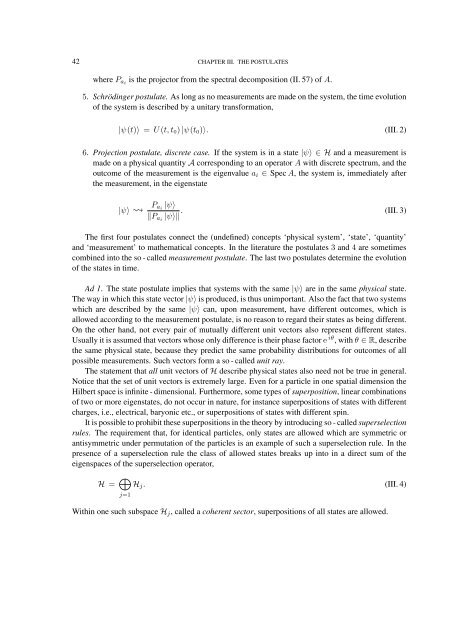FOUNDATIONS OF QUANTUM MECHANICS
FOUNDATIONS OF QUANTUM MECHANICS
FOUNDATIONS OF QUANTUM MECHANICS
Create successful ePaper yourself
Turn your PDF publications into a flip-book with our unique Google optimized e-Paper software.
42 CHAPTER III. THE POSTULATES<br />
where P ai is the projector from the spectral decomposition (II. 57) of A.<br />
5. Schrödinger postulate. As long as no measurements are made on the system, the time evolution<br />
of the system is described by a unitary transformation,<br />
|ψ(t)⟩ = U (t, t 0 ) |ψ(t 0 )⟩. (III. 2)<br />
6. Projection postulate, discrete case. If the system is in a state |ψ⟩ ∈ H and a measurement is<br />
made on a physical quantity A corresponding to an operator A with discrete spectrum, and the<br />
outcome of the measurement is the eigenvalue a i ∈ Spec A, the system is, immediately after<br />
the measurement, in the eigenstate<br />
|ψ⟩ P a i<br />
|ψ⟩<br />
. (III. 3)<br />
∥P ai |ψ⟩∥<br />
The first four postulates connect the (undefined) concepts ‘physical system’, ‘state’, ‘quantity’<br />
and ‘measurement’ to mathematical concepts. In the literature the postulates 3 and 4 are sometimes<br />
combined into the so - called measurement postulate. The last two postulates determine the evolution<br />
of the states in time.<br />
Ad 1. The state postulate implies that systems with the same |ψ⟩ are in the same physical state.<br />
The way in which this state vector |ψ⟩ is produced, is thus unimportant. Also the fact that two systems<br />
which are described by the same |ψ⟩ can, upon measurement, have different outcomes, which is<br />
allowed according to the measurement postulate, is no reason to regard their states as being different.<br />
On the other hand, not every pair of mutually different unit vectors also represent different states.<br />
Usually it is assumed that vectors whose only difference is their phase factor e iθ , with θ ∈ R, describe<br />
the same physical state, because they predict the same probability distributions for outcomes of all<br />
possible measurements. Such vectors form a so - called unit ray.<br />
The statement that all unit vectors of H describe physical states also need not be true in general.<br />
Notice that the set of unit vectors is extremely large. Even for a particle in one spatial dimension the<br />
Hilbert space is infinite - dimensional. Furthermore, some types of superposition, linear combinations<br />
of two or more eigenstates, do not occur in nature, for instance superpositions of states with different<br />
charges, i.e., electrical, baryonic etc., or superpositions of states with different spin.<br />
It is possible to prohibit these superpositions in the theory by introducing so - called superselection<br />
rules. The requirement that, for identical particles, only states are allowed which are symmetric or<br />
antisymmetric under permutation of the particles is an example of such a superselection rule. In the<br />
presence of a superselection rule the class of allowed states breaks up into in a direct sum of the<br />
eigenspaces of the superselection operator,<br />
H = ⊕ j=1<br />
H j . (III. 4)<br />
Within one such subspace H j , called a coherent sector, superpositions of all states are allowed.
















